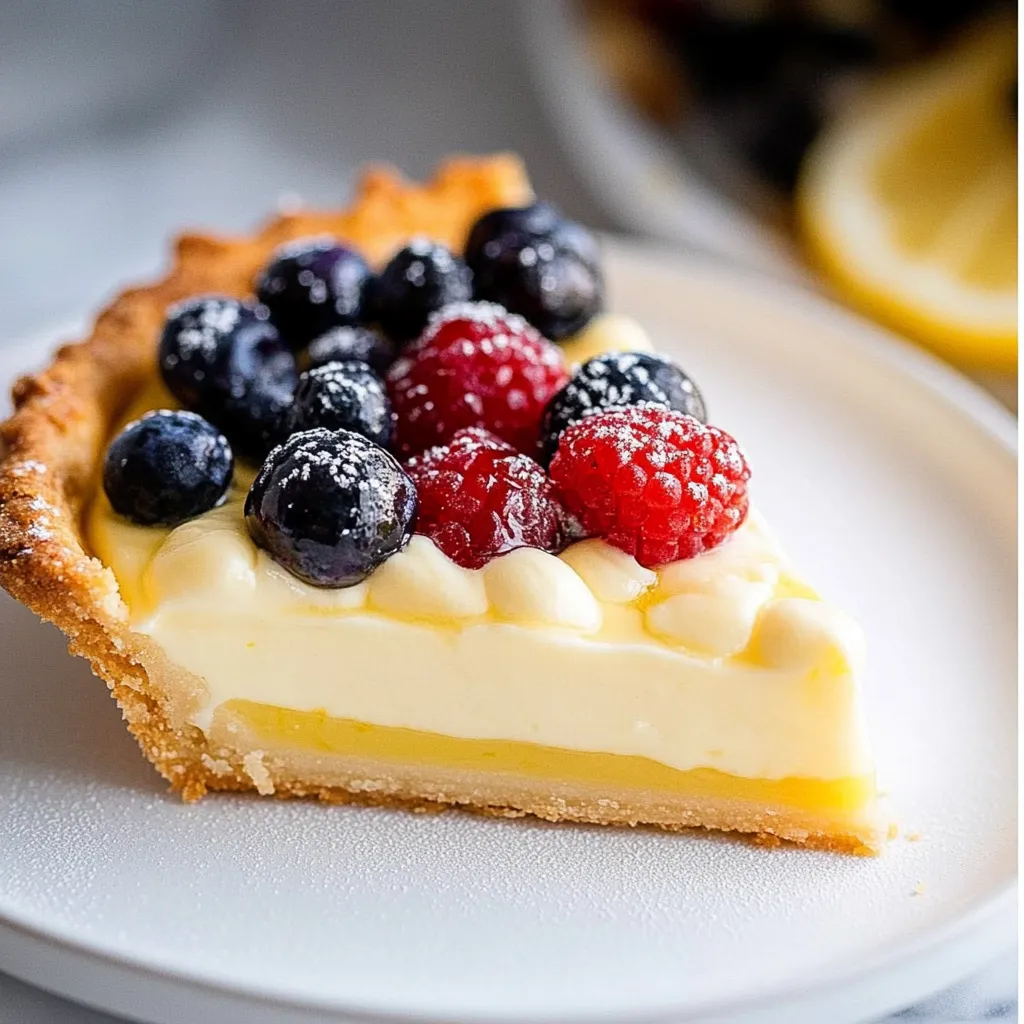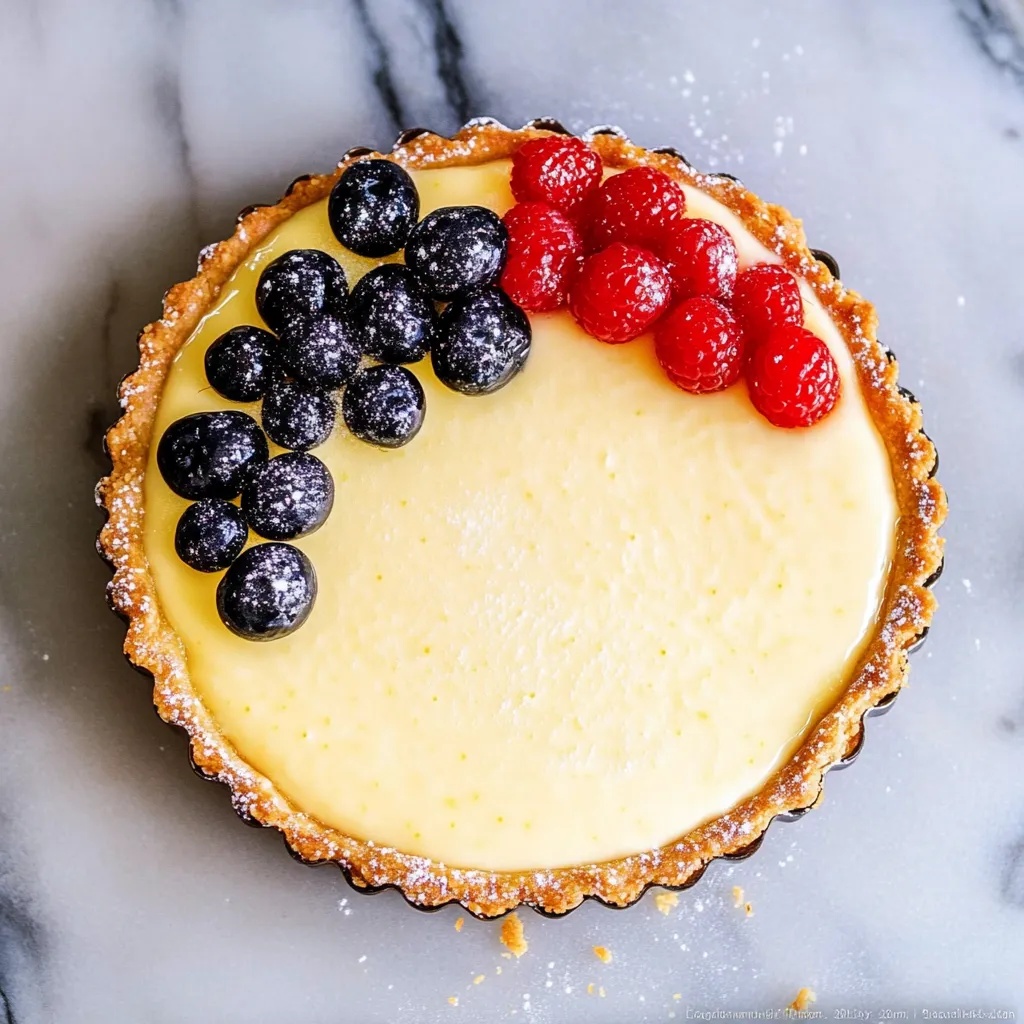 Save
Save
This French lemon cream tart delivers the perfect balance of sweet and tart with its silky smooth citrus filling nestled in a buttery shortcrust shell. Each bite offers an explosion of bright lemon flavor that makes it an ideal dessert for warm weather gatherings or whenever you crave something refreshingly indulgent.
I first made this tart for a summer dinner party, and it disappeared so quickly I barely saved a slice for myself. Now it's my go-to impressive dessert that never fails to earn compliments from even the most discerning guests.
Ingredients
- Baked tart shell: Using sweet shortcrust pastry provides the perfect buttery base
- Granulated sugar: Works best for incorporating the essential lemon oils
- Fresh lemon zest: Contains all the aromatic oils that give intense flavor
- Large eggs: Create structure and richness in the cream
- Fresh squeezed lemon juice: Offers bright acidity that bottled versions cannot match
- Unsalted butter: Cut into small pieces allows for proper emulsion and creates that signature silky texture
- Optional apricot jam: For glazing berries adds a professional looking shine
Step-by-Step Instructions
- Infuse Sugar:
- Place granulated sugar in a large bowl and use your hands to thoroughly rub in the lemon zest. This crucial step releases essential oils from the zest, infusing the sugar with intense lemon flavor. The sugar will become slightly moist and incredibly fragrant when done properly.
- Create Base Mixture:
- Whisk eggs and fresh lemon juice into the lemony sugar until completely combined. This mixture forms the foundation of your cream, so make sure everything is evenly incorporated before moving to the cooking stage.
- Cook The Custard:
- Transfer mixture to a heavy bottomed pot and cook over low to medium heat while whisking constantly. Patience is key here as rushing with high heat will scramble the eggs. Continue whisking until mixture reaches exactly 180°F, at which point it will thicken substantially. Use an instant read thermometer for precision as even a few degrees can affect the final texture.
- Strain And Cool:
- Immediately strain the hot mixture through a sieve into a clean bowl to remove any potential lumps or bits of cooked egg. Allow to cool for 10 to 15 minutes before proceeding. This cooling period ensures the butter emulsifies properly rather than simply melting.
- Emulsify With Butter:
- Transfer cooled mixture to a food processor and with the machine running, gradually add butter pieces, allowing a full minute of processing between additions. After all butter is incorporated, let the processor run for an additional 3 to 5 minutes. This extended processing creates the signature silky, airy texture that makes French lemon cream special.
- Chill And Set:
- Cover the cream with plastic wrap directly touching the surface to prevent skin formation. Refrigerate for at least 4 hours to properly set. The waiting is difficult but necessary for the flavors to meld and the texture to reach perfection.
- Assemble And Finish:
- Whisk the chilled cream to loosen it slightly before spreading into the tart shell with an offset spatula. Top with fresh berries and optionally brush with warmed apricot jam for a beautiful shine. Chill for at least 30 minutes before serving for best texture and flavor.
 Save
Save
My absolute favorite part of this recipe is watching guests take their first bite. There's always a moment of surprise when they experience how incredibly light yet intensely flavorful the lemon cream is compared to traditional lemon desserts they've had before.
Storing Your Tart
The completed tart should be stored in the refrigerator and is best consumed within 24 hours of assembly. While the lemon cream itself can last up to two days in the refrigerator, once assembled in the tart shell, the pastry will gradually soften. For make ahead convenience, prepare both components separately. Keep the lemon cream refrigerated in an airtight container with plastic wrap directly on the surface, and store the baked tart shell at room temperature. Assemble just a few hours before serving for optimal texture.
Perfecting The Texture
The secret to achieving the signature silky texture lies in temperature control and proper emulsification. Never rush the cooking process by turning up the heat. The cream should thicken gradually to avoid curdling the eggs. When adding butter, ensure it's truly at room temperature for proper incorporation. The extended processing time in the food processor creates microscopic butter droplets suspended throughout the cream, resulting in that luxurious mouthfeel that distinguishes French lemon cream from standard lemon curd. If your cream appears broken or curdled, it likely means either the base was too hot when butter was added or the butter was too cold.
Serving Suggestions
This elegant tart pairs beautifully with a dollop of lightly sweetened whipped cream or a scoop of vanilla bean ice cream for contrast. Fresh seasonal berries make the perfect topping. Consider serving with a glass of champagne or Sauternes for a sophisticated dessert experience. For a striking presentation, dust the edges with powdered sugar just before bringing to the table. The tart makes an impressive finale to a French inspired meal or as the centerpiece of an afternoon tea.
Recipe FAQs
- → Can I make this lemon tart in advance?
Yes, you can prepare components ahead of time. The sweet shortcrust can be baked 1-2 days ahead and stored in an airtight container. The lemon cream filling can be made up to two days in advance and kept refrigerated. Once assembled, the tart is best consumed within 5 hours for optimal texture and flavor.
- → Why does the lemon cream need to reach a specific temperature?
The lemon cream must reach 180°F/82°C to properly thicken the eggs without scrambling them. This precise temperature ensures the filling will set properly while maintaining a smooth, creamy texture. Using an instant-read thermometer is highly recommended for best results.
- → What can I use instead of a food processor for the lemon cream?
While a food processor creates the silkiest texture, you can use a blender as an alternative. If neither is available, vigorously whisk the mixture by hand while adding butter in small pieces, but be aware the texture may not be as perfectly smooth and airy as the food processor method.
- → Can I use bottled lemon juice instead of fresh?
Fresh lemon juice is strongly recommended for this tart as it provides a brighter, more authentic flavor. Bottled lemon juice often contains preservatives that can affect the taste. The recipe requires approximately 5 medium lemons for the juice and 3 for the zest.
- → What other fruits can I use to top the tart?
While berries like raspberries and blueberries are classic choices, you can also use sliced strawberries, blackberries, or a mix of stone fruits like peaches or nectarines when in season. For a winter version, try thinly sliced kumquats or candied citrus peel.
- → How do I prevent a skin from forming on my lemon cream?
Always place plastic wrap directly touching the surface of the lemon cream when chilling or storing. This creates a barrier that prevents air exposure which causes the skin to form. This step is crucial both when chilling the filling and after assembling the tart.
